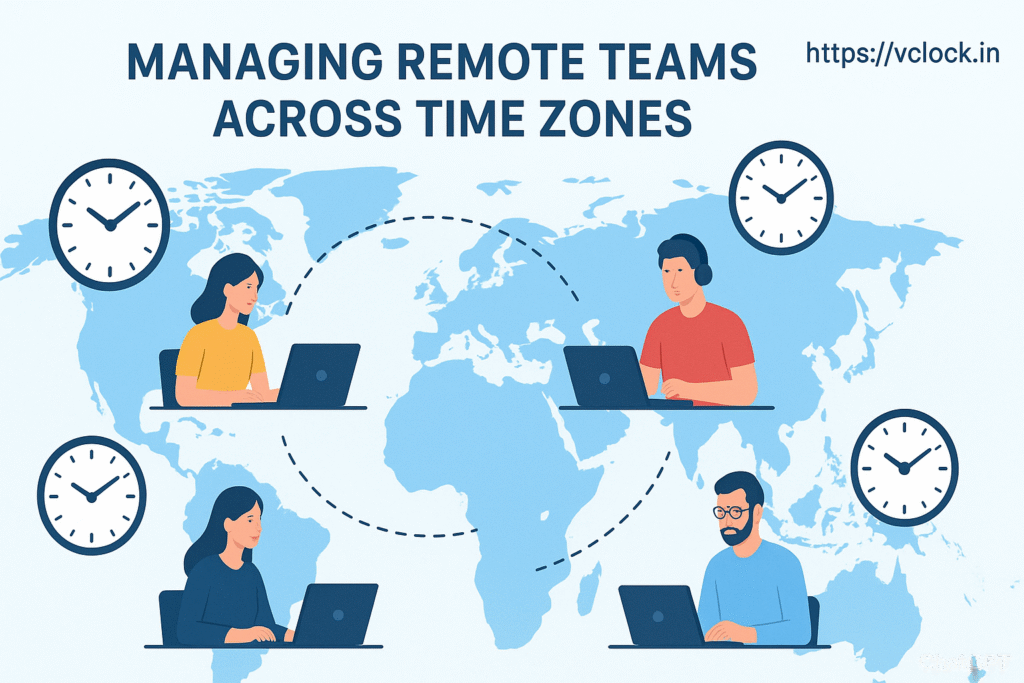Managing Remote Teams Across Time Zones

Mastering the Clock: A Practical Guide to Managing Remote Teams Across Time Zones
The modern workplace is no longer confined to a single office building. With the rise of remote work, teams have become global, bringing together diverse talent from every corner of the world. While this opens up incredible opportunities, it also introduces a significant challenge: managing teams scattered across multiple time zones.
For a manager, the question shifts from “Where is everyone?” to “When is everyone?” How do you foster collaboration when your team is asleep while you’re having your morning coffee? How do you maintain a cohesive company culture when team members never meet in person?
The key to success lies in intentional strategies and, most importantly, leveraging the right tools. As a platform dedicated to time management, vclock.in is here to provide a practical guide to navigating this new frontier.
1. Embrace Asynchronous Communication as Your Default
The first paradigm shift for any distributed team is moving from synchronous to asynchronous communication. Synchronous communication happens in real-time (like meetings or instant messaging expecting an immediate reply). Asynchronous communication allows people to contribute on their own schedules.
How to implement it:
Use the right tools: Prioritize platforms like Slack, Microsoft Teams, or project management tools like Asana and Trello. These allow team members to post updates, questions, and feedback that others can respond to when their workday begins.
Create detailed updates: Encourage team members to write clear, comprehensive messages and project briefs. This reduces the back-and-forth and prevents bottlenecks caused by waiting for a reply from someone in a different time zone.
Record important meetings: For any mandatory synchronous meetings, always record them. This allows absent team members to catch up without missing critical information.
2. Establish a “Golden Hour” for Overlap
Even with a focus on async work, some real-time interaction is essential for team bonding and complex discussions. The goal is to identify a “Golden Hour”—a small window of time where work hours overlap for all or most of your team.
How to implement it:
Map your team’s time zones: Use the tools on vclock.in to create a world clock view of where your team members are located. This visual aid is invaluable for quickly seeing available overlaps.
Protect the overlap: Schedule key collaborative meetings, brainstorming sessions, or even casual virtual coffee chats during this window. Avoid using this precious time for solitary deep work.
Be flexible and rotate: If the overlap consistently falls outside of standard working hours for some team members (e.g., very early or late), rotate meeting times. This shares the inconvenience fairly and shows respect for everyone’s personal time.
3. Set Clear Expectations, Not Micromanagement
Trust is the currency of remote work. Without the ability to look over someone’s shoulder, you must focus on outcomes rather than activity.
How to implement it:
Define deliverables clearly: Ensure every team member knows what is expected of them, by when, and what “done” looks like. Use SMART goals (Specific, Measurable, Achievable, Relevant, Time-bound).
Utilize project management software: Tools like Jira, Basecamp, or ClickUp provide transparency. Everyone can see the status of projects, who is responsible for what, and what the upcoming deadlines are, eliminating the need for constant status update meetings.
Focus on output: Judge performance by the quality and timeliness of work delivered, not by the number of hours logged or their online status on a messaging app.
4. Document Everything Religiously
In an async environment, documentation becomes your team’s collective brain. It prevents information from getting lost in direct messages or forgotten conversations.
How to implement it:
Create a central knowledge hub: Use a wiki like Notion, Confluence, or even a shared Google Drive folder. Store meeting notes, project guidelines, processes, and important decisions here.
Standardize your documentation: Have templates for meeting agendas, project kick-offs, and post-mortems. This makes it easy for anyone to find the information they need, quickly.
Promote a culture of documentation: Encourage team members to document their processes and share learnings. This turns individual knowledge into team knowledge.
5. Prioritize Connection and Company Culture
Remote work can be isolating. Proactively creating opportunities for connection is crucial to maintaining morale and a strong team spirit.
How to implement it:
Schedule virtual social events: Host non-work-related gatherings like trivia nights, virtual happy hours, or casual “water cooler” channels on Slack where people can chat about hobbies.
Celebrate wins publicly: Use a dedicated channel to shout out accomplishments, both big and small. This fosters a sense of shared success.
Encourage one-on-one connections: Facilitate virtual “coffee pairings” or buddy systems between team members who don’t normally work together directly to build cross-team relationships.
Leverage Your Secret Weapon: vclock.in
Managing time zones doesn’t have to be a headache. The tools on vclock.in are designed to simplify this exact challenge.
World Clock Converter: Quickly find the best meeting time for your entire team without manual calculations.
Meeting Planner: Visualize overlapping working hours to easily identify your team’s “Golden Hour.”
Set Customizable Alarms & Timers: Help team members in different zones stay on track with deadlines that are relevant to their local time.
Conclusion: Turn Time Zones into an Advantage
Managing remote teams across time zones is a skill that requires empathy, intention, and the right toolkit. By embracing asynchronous work, respecting personal boundaries, and fostering a strong documentation culture, you can transform the challenge of distance into a strategic advantage. Your team will benefit from increased flexibility, deeper focus, and access to a global talent pool.
Start by auditing your current communication habits and introduce one or two of these strategies. With patience and the smart use of tools from vclock.in, you can build a productive, happy, and truly global team.